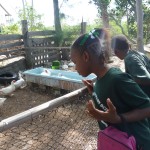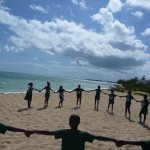For the past two weeks, Mark Hixon’s graduate students from Oregon State University (Alex Davis, Tye Kindinger, and Lillian Tuttle) have been busy SCUBA diving on their experimental reefs where  they are observing the ecological effects of invasive lionfish on native communities. Alex has been filming lionfish behavior at dusk, when lionfish are often actively hunting on the reefs. Tye is monitoring two species of native basslets (one of which is a popular aquarium fish) that could be threatened by lionfish predation. Lillian has been measuring densities of cleaner fishes, potential lionfish prey, which pick parasites off of other larger fishes, and are thus an important part of maintaining a healthy reef-fish community. Continue reading
they are observing the ecological effects of invasive lionfish on native communities. Alex has been filming lionfish behavior at dusk, when lionfish are often actively hunting on the reefs. Tye is monitoring two species of native basslets (one of which is a popular aquarium fish) that could be threatened by lionfish predation. Lillian has been measuring densities of cleaner fishes, potential lionfish prey, which pick parasites off of other larger fishes, and are thus an important part of maintaining a healthy reef-fish community. Continue reading
Monthly Archives: March 2013
Another visiting program experiences Eleuthera!
This eyewitness account was written by a student in the University School-Hathaway Brown Program:
 Before getting started, allow me to explain one reason why the Island School was such an eye-opening, incredible experience for my group and me. We are from Cleveland. Between the incessant snow and cloudy days, it seems that conservation is the last thing on our minds. So when our science research-based school club (the Anderson Scholars) of five boys, in addition to five girls (also interested in science research) from our all-girls sister school Hathaway Brown, received the notice that we would be spending a week in the beautiful, sunny Bahamas, we didn’t know what to expect.
Before getting started, allow me to explain one reason why the Island School was such an eye-opening, incredible experience for my group and me. We are from Cleveland. Between the incessant snow and cloudy days, it seems that conservation is the last thing on our minds. So when our science research-based school club (the Anderson Scholars) of five boys, in addition to five girls (also interested in science research) from our all-girls sister school Hathaway Brown, received the notice that we would be spending a week in the beautiful, sunny Bahamas, we didn’t know what to expect.
The Island School is its own microcosm of shape shifting individuals. From the engaging curriculum, an individual becomes a motivated student. From the hands-on outdoor activities, one becomes a 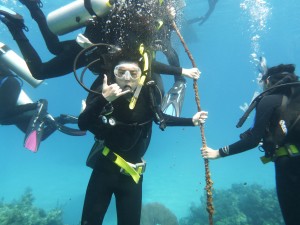 teammate. From the encouragement of others, one transforms into a leader. While most schools are trying to discover a way to make their curriculum applicable to the outside world, the Island School has already developed several tried and true methods to make it a precedent for said schools. The school is a place where the words “when will I ever use this outside of class?” will never be uttered from a student’s lips. The students are warm, outgoing, and most importantly, passionate; they are passionate about school, conservation, and lifting each other up. The science researchers are driven, and extremely helpful. Continue reading
teammate. From the encouragement of others, one transforms into a leader. While most schools are trying to discover a way to make their curriculum applicable to the outside world, the Island School has already developed several tried and true methods to make it a precedent for said schools. The school is a place where the words “when will I ever use this outside of class?” will never be uttered from a student’s lips. The students are warm, outgoing, and most importantly, passionate; they are passionate about school, conservation, and lifting each other up. The science researchers are driven, and extremely helpful. Continue reading
CEI/Island School Bridge to Shark Research in South Africa
On the Maxey’s recent trip to South Africa, Chris Maxey had the opportunity to visit the Save our Seas Shark Research Centre and met with Michael C. Scholl, CEO of Save Our Seas Foundation (SOSF). Michael is interested in expanding the educational outreach program at the Shark Centre and is sending two educators to join The Island School Teacher Conference this summer to help enhance the experiential elements of the new curriculum. Dr. Edd Brooks has been working with SOSF and the Shark Centre since 2006 and Chris Maxey’s son Brocq started working as an intern at the Shark Centre when he moved to Cape Town in 2009. Other Island School students have also participated in the research internship program.
There will be internship opportunities available both at the Shark Centre and also through an expeditionary organization, Shark Explorer, where Brocq Maxey currently works as a dive master and underwater photographer.
Picture caption: Chris and Brocq Maxey with Dr. Michael Scholl at the Centre
Earthwatch visits CEI
For ten days, seven volunteers representing four countries came to CEI to assist with data collection for a long term research project led by Dr Alastair Harborne from the Marine Spatial Ecology Lab. School of Biological Sciences, University of Queensland. The group was looking at mangrove and reef connectivity, along with scientists Rod Wilson and Kat Sloaman, who were investigating parrotfish behavior. Every day they ventured out to the patch reefs to conduct fish surveys and physical reef data. 
Interested in a CEI summer or fall internship?
Call for marine ecology, sustainable food production, and renewable energy-related intern applicants!
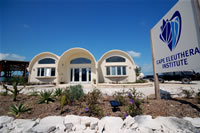 Interested in gaining experience in the marine sciences? Perhaps sustainable living and food production? Please note the approaching application deadlines:
Interested in gaining experience in the marine sciences? Perhaps sustainable living and food production? Please note the approaching application deadlines:
Summer 2013 intern application deadline: April 1, 2013
Fall 2013 intern application deadline: May 1, 2013
The Cape Eleuthera Institute, The Bahamas, is accepting intern applications for the following research programs: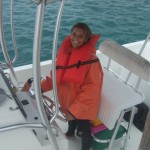
Flats Ecology and Conservation Program
Queen Conch Ecology and Conservation Program
Shark Research and Conservation Program
Open Ocean Aquaculture
Aquaponics and Permaculture
Lionfish Research and Educational Outreach Program
Engineering and Sustainable Systems
Biodigestion and Sustainable Development
Visit http://ceibahamas.org/internships.aspx for internship descriptions and instructions for applying.
Ice, Ice, Baby; It’s Getting Hot in Here!
Researchers with the Flats Ecology and Conservation Program are studying the critical thermal minimums (CTmin) and maximums (CTmax) of fish species representative of tropical nearshore flats and mangrove creek ecosystems. Specifically, bonefish, yellowfin mojarra, 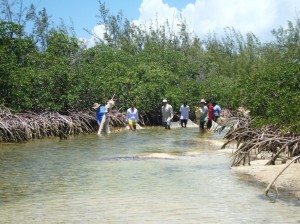 checkered puffer, and schoolmaster snapper were included in the study as model fishes due to their ecological (i.e., nutrient transporters and availability as forage for predatory species) and economic (i.e., sustenance and commercial fishing of snapper, and sport angling of bonefish) importance. The critical thermal is often used to quantify fish tolerance to extreme high or low temperatures and to determine fish resistance to different thermal events.
checkered puffer, and schoolmaster snapper were included in the study as model fishes due to their ecological (i.e., nutrient transporters and availability as forage for predatory species) and economic (i.e., sustenance and commercial fishing of snapper, and sport angling of bonefish) importance. The critical thermal is often used to quantify fish tolerance to extreme high or low temperatures and to determine fish resistance to different thermal events.
To test the capacity of these fishes for seasonal temperature acclimation, fish were collected from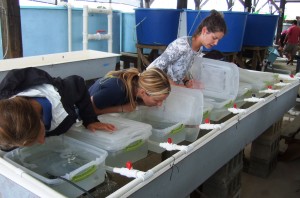 local mangrove creeks during either summer (warm seawater) or winter (cool seawater) months. During CT experiments, fish were placed in individual flow-through containers, and water temperature was gradually increased by electric water heater or decreased by ice for CTmax and CTmin trials, respectively. Periodically throughout each trial, researchers observed the rate of gill movements (i.e., “breathing” rate) and behavior of the fish. The experiment was finished when all fish lost equilibrium, or lost their ability to stay righted. Each fish was then brought back to ambient temperature, and were released following a full recovery.
local mangrove creeks during either summer (warm seawater) or winter (cool seawater) months. During CT experiments, fish were placed in individual flow-through containers, and water temperature was gradually increased by electric water heater or decreased by ice for CTmax and CTmin trials, respectively. Periodically throughout each trial, researchers observed the rate of gill movements (i.e., “breathing” rate) and behavior of the fish. The experiment was finished when all fish lost equilibrium, or lost their ability to stay righted. Each fish was then brought back to ambient temperature, and were released following a full recovery.
Picture captions: Top left CEI researchers and high school students collect checkered puffer from a nearby creek; Bottom right Researchers observe fish during a CT experiment.
Wemyss Bight Primary School visits CEI!
On Tuesday morning, CEI had an exciting visit from a local South Eleuthera primary school, Wemyss Bight Primary. Mrs. Paul’s grade 4 class came for a morning field trip as a way to supplement their curriculum on the topics of ocean resources, ocean pollution, and ocean movement (tides & currents). While visiting our campus, they explored the various sustainable systems including the farm, orchard, biodiesel lab, resource center and the wet lab.
The wetlab proved to be one of the most exciting spots on campus, as this group of 10 year olds was able to see juvenile lemon sharks, yellow stingrays, checkered pufferfish and the freshwater tilapia found in our aquaponics system. This gave them a taste of some of the current research projects at Cape Eleuthera Institute and the valuable marine resources found here in the Bahamas. Continue reading
BNNHC Update #3
The Bahamas National Natural History Conference wrapped up on Friday Mar. 8.  The fourth and final day of the conference included an informative session dealing with queen conch ecology and management. CEI’s Claire Thomas gave a presentation on the status of queen conch populations in South Eleuthera. The populations are in decline, and Claire presented powerful graphs showing a significant decrease in adult conch in Cape Eleuthera, utilizing data collected by previous CEI queen conch researchers Erin Cash and Steve Auscavitch. Catherine Booker from Community Conch also spoke on reconsidering queen conch management in the Bahamas, and showed data from population surveys that
The fourth and final day of the conference included an informative session dealing with queen conch ecology and management. CEI’s Claire Thomas gave a presentation on the status of queen conch populations in South Eleuthera. The populations are in decline, and Claire presented powerful graphs showing a significant decrease in adult conch in Cape Eleuthera, utilizing data collected by previous CEI queen conch researchers Erin Cash and Steve Auscavitch. Catherine Booker from Community Conch also spoke on reconsidering queen conch management in the Bahamas, and showed data from population surveys that  Community Conch has done, revealing a disturbing trend that remaining stocks may not have high enough densities for mating to occur. Following the conch talks was a roundtable discussion, where a steering committee was formed to address the new idea of “conch”servation. The committee consists of government officials, representatives from NGOs including CEI, the Bahamas National Trust, and BREEF, and conch fishermen. Continue reading
Community Conch has done, revealing a disturbing trend that remaining stocks may not have high enough densities for mating to occur. Following the conch talks was a roundtable discussion, where a steering committee was formed to address the new idea of “conch”servation. The committee consists of government officials, representatives from NGOs including CEI, the Bahamas National Trust, and BREEF, and conch fishermen. Continue reading
Intern profile: Melissa Dick
Here is a short bio from the Flats intern Melissa:
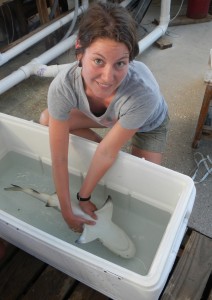 I grew up in the countryside of Gatineau, Quebec, Canada where I developed a love for the outdoors and learning about the natural world. I pursued a Bachelor of Science degree in Geography at Carlton University in Ottawa, Ontario, Canada which exposed me to an array of interesting research questions associated with the physical environment. I had the amazing opportunity to be directly involved in research projects, leading to a directed study in dendroarchaeology in which I found the year of origin of heritage log buildings based on the tree-ring sequence sampled from the structure. For my undergraduate thesis, I studied the influence of watershed characteristics and lake chemistry variables on concentrations of mercury in 12 lakes in the Gatineau Park, Quebec, Canada.
I grew up in the countryside of Gatineau, Quebec, Canada where I developed a love for the outdoors and learning about the natural world. I pursued a Bachelor of Science degree in Geography at Carlton University in Ottawa, Ontario, Canada which exposed me to an array of interesting research questions associated with the physical environment. I had the amazing opportunity to be directly involved in research projects, leading to a directed study in dendroarchaeology in which I found the year of origin of heritage log buildings based on the tree-ring sequence sampled from the structure. For my undergraduate thesis, I studied the influence of watershed characteristics and lake chemistry variables on concentrations of mercury in 12 lakes in the Gatineau Park, Quebec, Canada.
I couldn’t get enough of doing field work on lake and stream systems, so in the autumn of 2012 I worked as a field assistant for both the Geography department of Carleton University and the Rideau Valley Conservation Authority, which included catching fish in lakes of the Gatineau Park and taking muscle biopsy samples which were tested for mercury concentrations, and collecting and identifying benthic macroinvertebrates to assess the health of streams. Continue reading
BNNHC Update #2
Day 2 of the Bahamas National Natural History Conference had a session devoted to new research 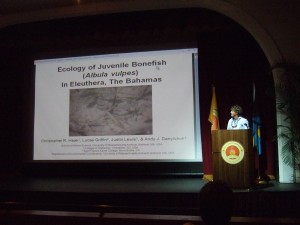 on life history and management of a popular gamefish of the Bahamas, the bonefish (Albula vulpes). The bonefish session, moderated by Dr. Dave Philipp, Executive Director of the Fisheries Conservation Foundation (FCF), started off with a talk by UMass PhD student Chris Haak, who discussed his findings on the early life history of bonefish. With his findings, he theorized that juvenile bonefish actually mimic another species in the flats ecosystem, mottled mojarra, as a way to blend in with their schools for protection from predation.
on life history and management of a popular gamefish of the Bahamas, the bonefish (Albula vulpes). The bonefish session, moderated by Dr. Dave Philipp, Executive Director of the Fisheries Conservation Foundation (FCF), started off with a talk by UMass PhD student Chris Haak, who discussed his findings on the early life history of bonefish. With his findings, he theorized that juvenile bonefish actually mimic another species in the flats ecosystem, mottled mojarra, as a way to blend in with their schools for protection from predation.
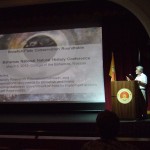
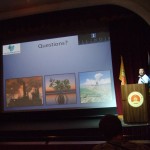 Next to speak was Dr. Karen Murchie from the College of the Bahamas, talking about movement patterns in bonefish and experiments with acoustic telemetry. She found that bonefish move regularly among tidal creeks in South Eleuthera, and was able to follow some fish for almost two years! Dave Philipp then discussed the reproductive ecology of bonefish, and some implications for conservation in the Bahamas. He emphasized the importance of determining source/sink populations to inform management. Continue reading
Next to speak was Dr. Karen Murchie from the College of the Bahamas, talking about movement patterns in bonefish and experiments with acoustic telemetry. She found that bonefish move regularly among tidal creeks in South Eleuthera, and was able to follow some fish for almost two years! Dave Philipp then discussed the reproductive ecology of bonefish, and some implications for conservation in the Bahamas. He emphasized the importance of determining source/sink populations to inform management. Continue reading


